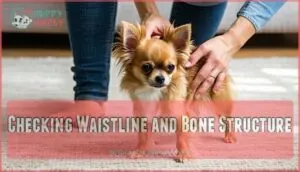This site is supported by our readers. We may earn a commission, at no cost to you, if you purchase through links.

You should be able to feel their ribs without pressing hard, and see a visible waist when looking from above.
If you can’t, it’s time for action. These pocket-sized pups weren’t built for excess pounds, and even one extra pound can equal 20% of their body weight.
Cut back on treats, measure food portions carefully, and increase their daily walks. Don’t let those puppy-dog eyes fool you into overfeeding.
The path to a healthier, happier chihuahua starts with understanding the hidden dangers lurking beneath that extra fluff.
Table Of Contents
- Key Takeaways
- Identifying Overweight Chihuahuas
- Causes of Weight Gain
- Health Risks of Obesity
- Strategies for Weight Loss
- Maintaining Healthy Weight
- Recognizing Obesity Symptoms
- Preventing Obesity in Chihuahuas
- Frequently Asked Questions (FAQs)
- Why is my Chihuahua chubby?
- Is a 10 pound Chihuahua overweight?
- Can a Chihuahua be 20 lbs?
- How long can a fat Chihuahua live?
- What is the ideal weight for a Chihuahua?
- What kind of exercise is best for a Chihuahua?
- How much food should a Chihuahua be fed?
- Are there any supplements that can help a Chihuahua lose weight?
- Are there any health risks associated with being overweight?
- Can spaying/neutering affect Chihuahua weight gain?
- Conclusion
Key Takeaways
- Check if your Chihuahua’s overweight by feeling their ribs—you should easily feel them through a thin layer of fat, and see a visible waist when looking from above
- Cut calories immediately by measuring food portions precisely, eliminating table scraps completely, and limiting treats to less than 10% of daily calories
- Increase daily exercise gradually with short walks twice daily, indoor games like fetch, and interactive toys to boost metabolism without overwhelming your tiny pup
- Monitor weight monthly and visit your vet regularly to track progress, adjust diet plans, and catch health issues like diabetes, joint problems, or breathing difficulties before they become serious
Identifying Overweight Chihuahuas
You can identify an overweight Chihuahua by checking for a visible waist and feeling their ribs.
A healthy Chihuahua should feel like a dog, not a plush toy—ribs easy to find, waist clearly defined.
If their waistline isn’t tucked or their ribs are hard to find, they likely have excess fat.
Checking Waistline and Bone Structure
To know if your Chihuahua is overweight, check its waistline and bones. A healthy waist should tuck inward, not round out.
Use your hands and feel for these:
- Waistline Definition: Look for a slim midsection.
- Ribcage Fat Coverage: Feel ribs under a thin fat layer.
- Spinal Palpation: Gently touch the spine.
- Shoulder Blade Check: Shouldn’t feel buried in fat.
- Hip Bone Feel: Lightly noticeable yet cushioned.
Feeling Ribs for Excess Fat
To check if your Chihuahua’s carrying extra weight, feel their ribcage.
Use gentle palpation techniques—ribs should be easy to feel under a thin fat layer.
If ribs feel padded or the bone structure isn’t obvious, your dog might be overweight.
Avoid confusing an “ideal rib feel” with being underweight; balance matters.
Dog obesity impacts chihuahua health long-term.
Visible Waist and Tucked Abdomen
A healthy Chihuahua should show an ideal silhouette with a noticeable abdominal tuck when viewed from their side.
Evaluating the waistline is key—your pup’s body condition should reveal a defined, narrower waist compared to their ribcage.
Visual cues, like the absence of a “barrel-shaped” look, indicate good chihuahua health.
Dog obesity is common, so monitor closely to prevent a fat dog.
Difficulty Feeling Bones and Joints
If your Chihuahua feels more like a plush toy than a pet, it’s time to assess their body.
Bone palpation is key—gently feel for shoulders, spine, and hips.
Fat interference makes joints harder to locate, and muscle atrophy may occur in overweight dogs.
Dog obesity also restricts joint mobility, leaving your fat dog uncomfortable.
Always consider professional pain assessments for a proper body condition score.
Causes of Weight Gain
Your Chihuahua’s weight gain often comes from too much food, too many treats, or human table scraps sneaking into their diet.
Pair that with little exercise, and those extra calories quickly turn into stubborn fat.
Overfeeding and High-Calorie Foods
Portion sizes matter more than you think.
Overfeeding, even with "healthy" dog food, piles on unnecessary calories. Table scraps? They’re a fast track to weight gain—think calorie bombs wrapped in guilt.
Instead, focus on treat alternatives like low-cal options. Check food labels for calorie density and stick to dietary guidelines.
A switch to high-protein dog foods may also help with weight management. Small changes can keep your Chihuahua from tipping the scales!
Lack of Exercise and Physical Activity
Skipping the daily dog walk? That’s a recipe for trouble! The Chihuahua breed’s low energy expenditure makes regular dog exercise essential to avoid dog obesity.
Limited mobility isn’t an excuse—try these indoor activities:
- Tug-of-war with a soft toy.
- Short fetch games to raise activity levels.
- Puzzle feeders to engage their minds.
- Gentle stretching for exercise alternatives, which can help maintain their physical and mental health.
Table Scraps and Human Food
It’s tempting to share table food when your pup gives you those begging eyes, but portion accumulation and treats can quickly lead to weight gain.
Plus, many ingredients are toxic, like garlic and onions, causing digestive issues.
Stick to acceptable treats like plain, skinless chicken.
Owner education is key—overfeeding, even with love, harms your Chihuahua’s health.
| Food Type | Calories (Per Oz) | Digestive Impact | Risk Level | Alternatives |
|---|---|---|---|---|
| Table Scraps | High (Varies) | Overloads Stomach | Moderate-High | None |
| Garlic/Onions | Toxic | Severe Damage | High | Avoid Entirely |
| Burger Scraps | High Fat | Upset Stomach | Moderate | Plain Chicken (No Skin) |
| Cheese | High Calories | Hard to Digest | Moderate | Small, Low-Fat Cheese |
| Skinless Chicken | Protein-Rich | Improves Digestion | Low | Best Occasional Treat |
Health Risks of Obesity
Carrying extra weight isn’t just uncomfortable for your Chihuahua; it’s dangerous. Obesity can lead to serious problems like diabetes, joint pain, and even trouble breathing.
Diabetes and Insulin Resistance
Excess weight can mess with your pup’s insulin sensitivity, making glucose regulation a challenge.
Insulin resistance develops, leading to canine diabetes, where blood sugar spikes out of control.
Diet impact plays a huge role—high-fat or carb-heavy foods worsen the issue.
Managing diabetic conditions involves blood testing and customized diets.
Consistent feeding times are essential for glycemic control.
Keep your Chihuahua healthy to avoid diabetic management struggles.
High Blood Pressure and Heart Disease
When your Chihuahua carries extra weight, it strains their heart, leading to high blood pressure (hypertension) and increasing the risk of heart disease.
Obesity impacts canine heart health and can cause organ failure over time.
A balanced diet and regular exercise improve heart health, lowering blood pressure and preventing hypertension.
Don’t underestimate the benefits of addressing dog obesity early to improve overall heart health.
Joint Problems and Arthritis
Joint problems and arthritis come quickly to overweight Chihuahuas, even with just a few extra pounds. That extra weight pressures joints, speeds up cartilage damage, and worsens pain.
- Early detection is essential to pain management.
- Keep them active to support mobility.
- Use joint-friendly food.
- Consider mobility aids for comfort.
- Reduce calories to lessen weight impact on joints.
One common issue to look out for is luxating patella, which can be addressed through these measures to improve the dog’s mobility and overall health.
Respiratory Issues and Breathing Difficulties
Obesity in small dogs like Chihuahuas often leads to breathing difficulties.
Chest fat pressure limits lung expansion, causing snoring problems and exercise intolerance.
They may struggle to cool down, especially in warmer weather.
Here’s a breakdown:
| Problem | Cause | Solution |
|---|---|---|
| Snoring Problems | Chest fat pressure | Weight loss & vet care |
| Exercise Intolerance | Obesity | Increase daily walks |
| Cooling Difficulties | Lung expansion issues | Keep them hydrated |
The solutions aim to address the root causes, such as obesity, and alleviate symptoms like exercise intolerance.
Strategies for Weight Loss
Helping your Chihuahua lose weight starts with a simple plan that combines diet changes and more movement.
By focusing on portion control, healthy foods, and daily exercise, you can keep your pup on track to a healthier weight.
Increasing Daily Exercise and Activity
To boost your Chihuahua’s fitness, make exercise fun! Dogs love variety, so mix it up with these ideas:
- Walking Schedules: Short, brisk walks twice daily keep them active.
- Playtime Ideas: Try fetch with interactive toys for mental and physical stimulation.
- Agility Training: Teach basic jumps or tunnels for balance and strength.
Consider small dog agility equipment to enhance training. Consistency guarantees their daily exercise stays effective.
Changing Diet to High-Fiber Foods
Switching to a high-fiber dog diet can be a game-changer for your pup’s weight loss.
Fiber benefits digestion, keeps your Chihuahua fuller, and supports better dog nutrition.
Gradually switch with foods like green beans or pumpkin to avoid tummy troubles.
Check food labels for calories and portion control, and for various options, consider high fiber options.
Always monitor hydration needs to keep everything balanced and effective, ensuring a successful transition to a new diet with better dog nutrition.
Reducing Treats and Table Food
Cutting back on treats and table food is key to tackling pet obesity.
Gradual reduction helps your Chihuahua adjust while avoiding tantrums. Opt for treat alternatives like carrot slices or low-calorie dog snacks.
Educate the family about overfeeding risks and ingredient awareness.
Treats shouldn’t replace meals—stick to portion control and reinforce healthy habits to support your dog’s diet.
Monitoring Calorie Intake and Portion Control
How do you keep your Chihuahua’s weight in check? Start with portion control. Measure portions precisely using food labels as a guide, but remember, they often overestimate.
Calculate calories based on your dog’s size, adjusting feeding portions as needed. To guarantee accurate feeding, use a dog food calculator to determine the appropriate amount.
Stick to feeding schedules, limit treats, and monitor weight monthly. Small calorie adjustments make a big difference for Chihuahua food and health!
Maintaining Healthy Weight
Once you’ve helped your Chihuahua reach their target weight, you’ll need to focus on keeping those pounds off for good.
This means sticking to proper portion sizes, regular vet visits, and daily exercise to prevent your pup from gaining weight again.
Regular Veterinary Check-Ups
Nobody wants to play guessing games with their Chihuahua’s health.
Regular veterinary assessments provide early detection of weight-related dog health issues before they become serious problems.
Your veterinarian offers professional advice, creates personalized plans for Chihuahua care, and monitors progress through preventative care visits.
These check-ups guarantee your pet health stays on track with expert monitoring.
Balanced and Nutritious Diet
Your Chihuahua’s complete balanced dog food should pack high-quality protein sources like chicken or fish as the foundation.
Fiber importance can’t be overstated—it keeps your pup feeling full longer, which is why fiber supports satiety.
Healthy fats support their coat and brain function.
While most premium Chihuahua food covers vitamin supplements and hydration needs, always choose formulas designed for small breeds to maximize pet nutrition.
To guarantee the best health, consider how fiber supports satiety.
Proper Portion Control and Feeding Schedule
Getting your chihuahua food portions right isn’t rocket science, but it does require some math.
Most Chihuahuas need 40 calories per pound of body weight daily. A proper dog feeding guide helps you create a solid dog diet plan that keeps your pup satisfied without overdoing it.
- Calorie Calculation: Multiply your dog’s ideal weight by 40 to determine daily calorie needs
- Measuring Food: Use a kitchen scale or measuring cup to guarantee accurate portions every meal
- Feeding Frequency: Split daily calories into 2-3 smaller meals to boost metabolism and prevent overeating
- Treat Limits: Keep treats under 10% of total daily calories, adjusting portions accordingly for superior pet nutrition
Encouraging Physical Activity and Play
Physical activity doesn’t have to feel like boot camp for your Chihuahua.
Interactive toys keep tiny paws moving indoors, while outdoor adventures provide fresh air stimulation.
Agility training builds confidence and burns calories.
Indoor games like hide-and-seek work perfectly on rainy days.
Socialization playdates combine exercise with fun, and your dog’s fitness journey becomes enjoyable when play drives the weight loss process.
Recognizing Obesity Symptoms
You can spot obesity in your Chihuahua by checking if you can’t easily feel their ribs through their coat or if their waist has disappeared when viewed from above.
Watch for signs like low energy levels, heavy breathing after light activity, and visible fat around their neck and shoulders that weren’t there before, which can indicate obesity.
Difficulty Feeling Ribs and Spine
The easiest rib palpation guide involves running your hands along your Chihuahua’s sides.
You should feel ribs easily with slight pressure through a thin fat layer thickness.
If you can’t locate the spine or ribs without pressing hard, your dog’s carrying excess weight.
Healthy body condition means distinguishing muscle vs. fat – ribs shouldn’t disappear under thick padding, which indicates a healthy body condition.
Visible Fat and Weight Gain
Excess weight becomes obvious when your Chihuahua’s body takes on a rounded, barrel-like shape.
You’ll notice fat distribution around the neck, shoulders, and hips where lean muscle should be.
This breed predisposition to obesity means even small weight gain is visible.
Age-related changes and reduced activity levels make dog weight issues more apparent through accumulated fat deposits, leading to a noticeable impact on the dog’s overall health and well-being.
Low Energy Levels and Lethargy
Your Chihuahua’s sudden couch potato behavior might signal obesity trouble.
Recognizing fatigue becomes easier when you notice your pup avoiding stairs or refusing walks they once loved.
Activity intolerance develops as excess weight drains their natural energy.
Causes of lethargy in overweight Chihuahuas include joint strain and metabolic changes.
Veterinary evaluation helps determine if weight affects your dog’s stamina and liveliness.
Breathing Difficulties and Respiratory Issues
When your Chihuahua huffs and puffs after minimal activity, chest fat might be squeezing their lung capacity like a tight sweater.
This small dog breed faces serious airway obstruction from obesity, leading to exercise intolerance and cooling problems.
You’ll notice labored breathing, especially during warm weather, as excess weight restricts their respiratory health substantially.
One potential cause of this is rapid breathing, which can indicate underlying health issues.
Preventing Obesity in Chihuahuas
You can protect your Chihuahua from becoming overweight by controlling their food portions and providing daily exercise.
Prevention is much easier than weight loss, so start good habits early to keep your tiny companion healthy and active throughout their life.
Avoiding Overfeeding and Table Scraps
You’re the gatekeeper of your Chihuahua’s food bowl, and that’s a big responsibility.
These tiny pups need strict portion control to avoid becoming chunky little potatoes. Table food might seem harmless, but it’s like giving candy to a toddler – tempting but dangerous.
Here’s your prevention playbook:
- Measure meals precisely – Use a kitchen scale for accurate portions
- Replace high-calorie treats with carrot sticks or green beans
- Ban table scraps completely – Human food dangers include toxic ingredients
- Stick to scheduled meals instead of free-feeding throughout the day
- Choose balanced diet formulas designed specifically for small breed dogs
Providing Regular Exercise and Activity
Your Chihuahua needs daily exercise to stay trim. Start with short walks and indoor activities like fetch or hide-and-seek.
Leash training helps build confidence outdoors. Add playtime variety through puzzle toys for mental stimulation.
Simple agility training using household items keeps things fun. These dog fitness routines help increase activity levels without overwhelming your tiny companion, providing mental stimulation.
Monitoring Weight and Adjusting Diet
Regular exercise sets the foundation, but tracking your chihuahua weight through consistent monitoring creates lasting results.
Weigh your pup monthly and record changes on weight charts to spot trends early. Calorie counting paired with reading food labels helps you make informed diet changes that support healthy chihuahua development.
A Body Condition Score can also help assess your dog’s weight.
- Portion sizes should match your dog’s current weight – not their target weight – and adjust gradually as pet weight decreases
- Food labels reveal hidden calories – compare brands to find lower-calorie options that maintain chihuahua nutrition quality
- Weekly weigh-ins catch problems fast – sudden changes in dog weight loss progress signal when to modify your approach
Consulting With Veterinarian for Guidance
When your chunky Chihuahua needs professional help, your veterinarian becomes your best ally.
They’ll conduct thorough vet weight checks and health risk assessments to create personalized diet plans suited to your pup’s needs.
A qualified health care provider offers exercise recommendations and considers medication considerations that you can’t get from online advice.
Professional veterinary advice guarantees safe, effective weight loss through proper medical diagnosis.
Frequently Asked Questions (FAQs)
Why is my Chihuahua chubby?
Your Chihuahua’s chubbiness likely stems from overfeeding, too many treats, or lack of exercise.
These tiny dogs need surprisingly few calories daily.
Cut portions, eliminate table scraps, and increase walks to restore their healthy weight.
Is a 10 pound Chihuahua overweight?
Yes, a 10-pound Chihuahua is definitely overweight.
According to AKC standards, healthy Chihuahuas shouldn’t exceed 6 pounds.
Your pup’s carrying nearly double the recommended weight, which puts stress on joints and organs.
Can a Chihuahua be 20 lbs?
While technically possible, a 20-pound Chihuahua would be severely obese and facing serious health risks. You’d basically have a dog that’s triple the healthy weight limit, requiring immediate veterinary intervention.
How long can a fat Chihuahua live?
Time’s ticking faster for overweight pups.
Your chunky Chihuahua’s lifespan drops substantially – from 14-16 years to potentially 10-12 years.
Obesity triggers diabetes, heart disease, and joint problems that’ll steal precious years together, due to obesity.
What is the ideal weight for a Chihuahua?
According to American Kennel Club standards, your Chihuahua should weigh six pounds or less.
You’ll know they’re at their ideal weight when you can easily feel their ribs with minimal fat coverage.
What kind of exercise is best for a Chihuahua?
Daily walks work best for Chihuahuas – aim for 1-2 short sessions.
Indoor games like fetch or hide-and-seek also help.
Start slowly and build endurance. Your tiny companion needs consistent, gentle exercise to stay healthy and happy.
How much food should a Chihuahua be fed?
A little goes a long way with these tiny companions.
Feed your Chihuahua ¼ to ½ cup of high-quality dry food daily, split into two meals.
Adjust portions based on age, activity level, and your vet’s recommendations.
Are there any supplements that can help a Chihuahua lose weight?
You should consult your vet before giving weight-loss supplements to your Chihuahua.
Most vets recommend diet changes and exercise first.
Some supplements can interact with medications or cause side effects in small dogs.
Are there any health risks associated with being overweight?
Carrying extra pounds is like a ticking time bomb for your Chihuahua’s health.
You’ll see breathing problems, joint pain, diabetes, heart disease, and back issues that can seriously shorten their lifespan and quality of life, leading to a potentially shortened lifespan.
Can spaying/neutering affect Chihuahua weight gain?
Yes, spaying and neutering can affect your Chihuahua’s weight.
These procedures reduce metabolism by 20-30%, making weight gain easier.
You’ll need to adjust food portions and increase exercise to prevent obesity after surgery.
Conclusion
Transforming your fat chihuahua from a pudgy pup to a healthy companion requires dedication and consistency.
You’ve learned to identify excess weight, understand health risks, and implement effective strategies.
Monitor portion sizes, increase exercise gradually, and eliminate table scraps.
Regular vet visits confirm you’re on track.
Remember, even small changes create big results for tiny dogs.
Your chihuahua’s future depends on the choices you make today to have a happier, healthier pet.
Start implementing these tips now for a happier, healthier pet.


















